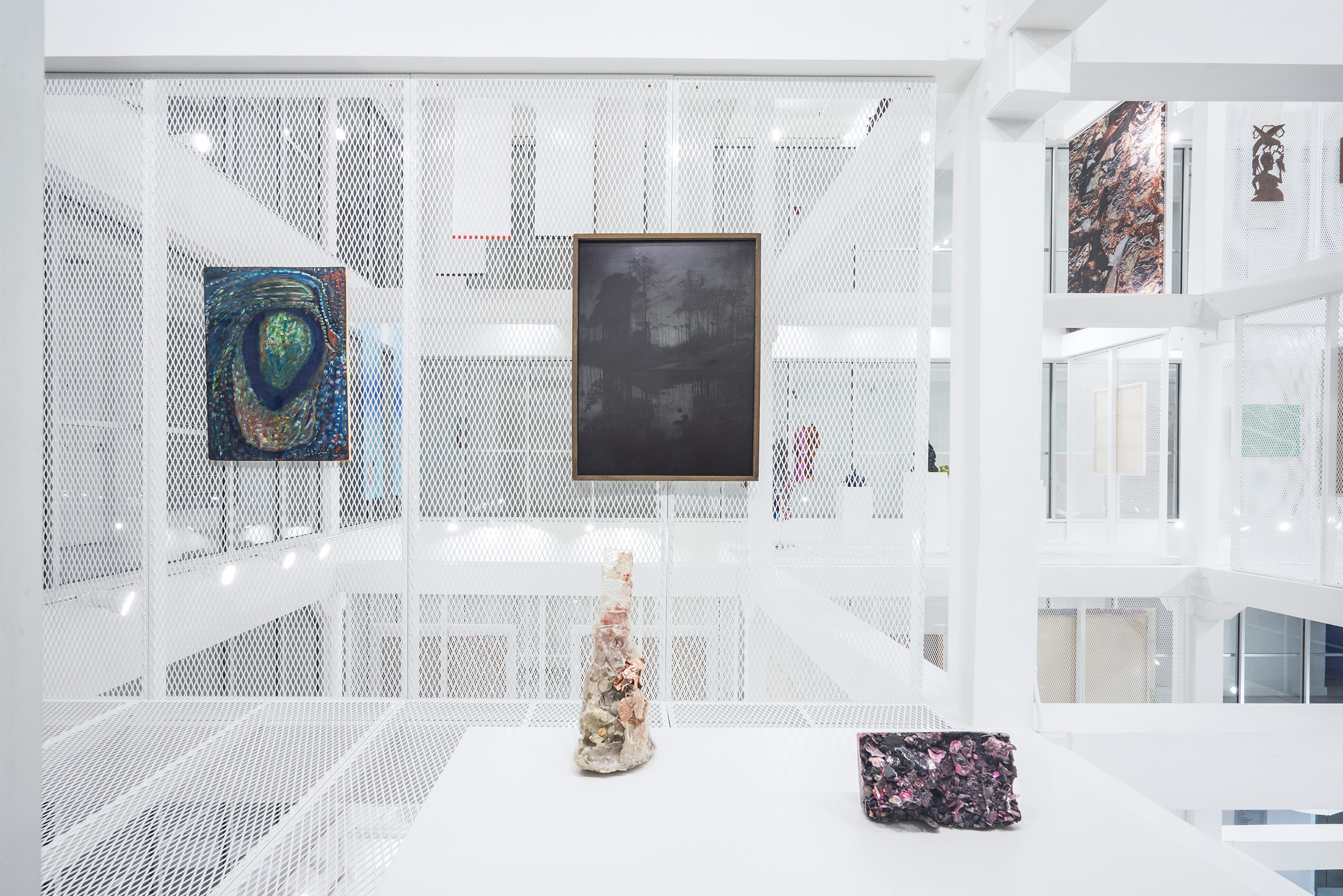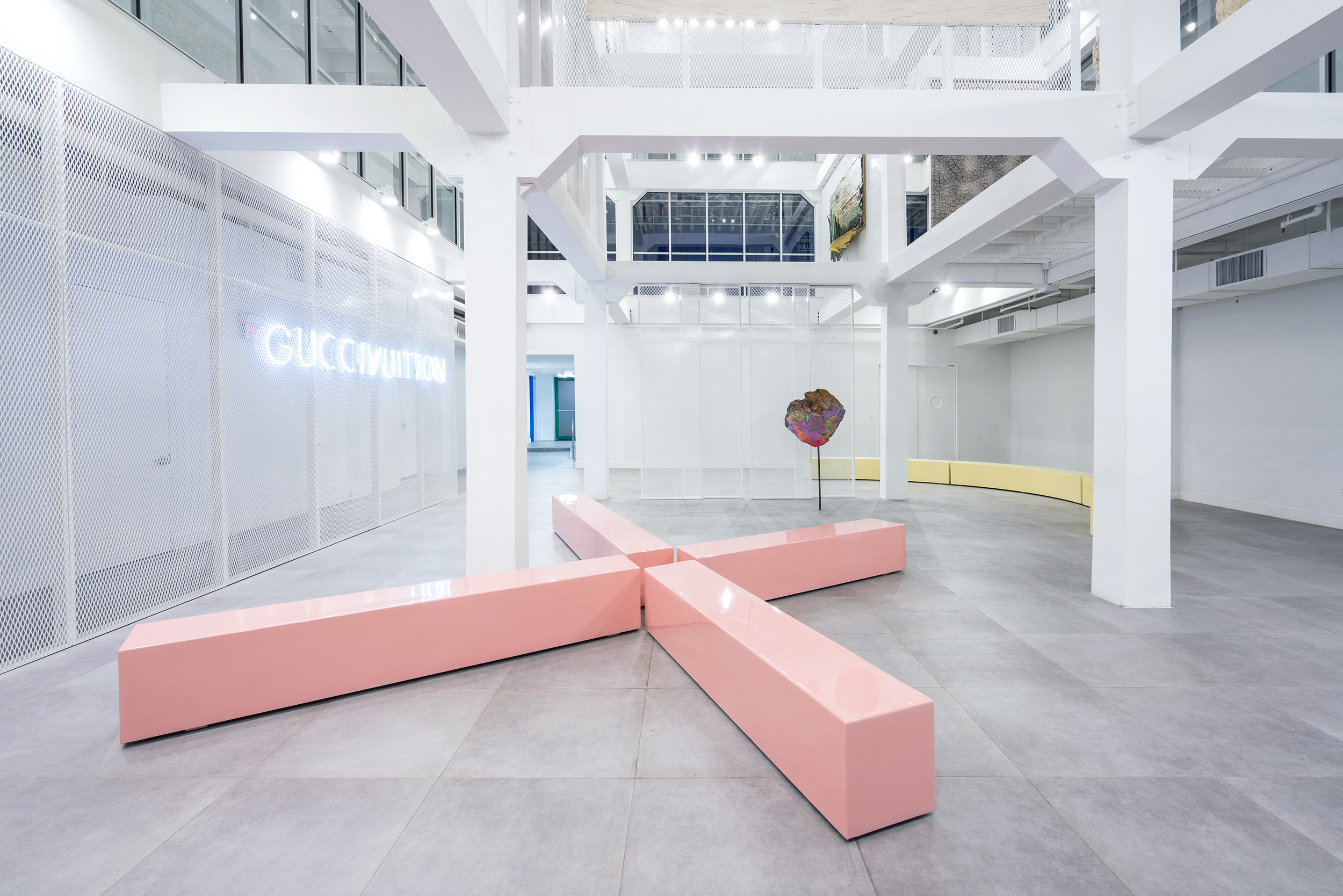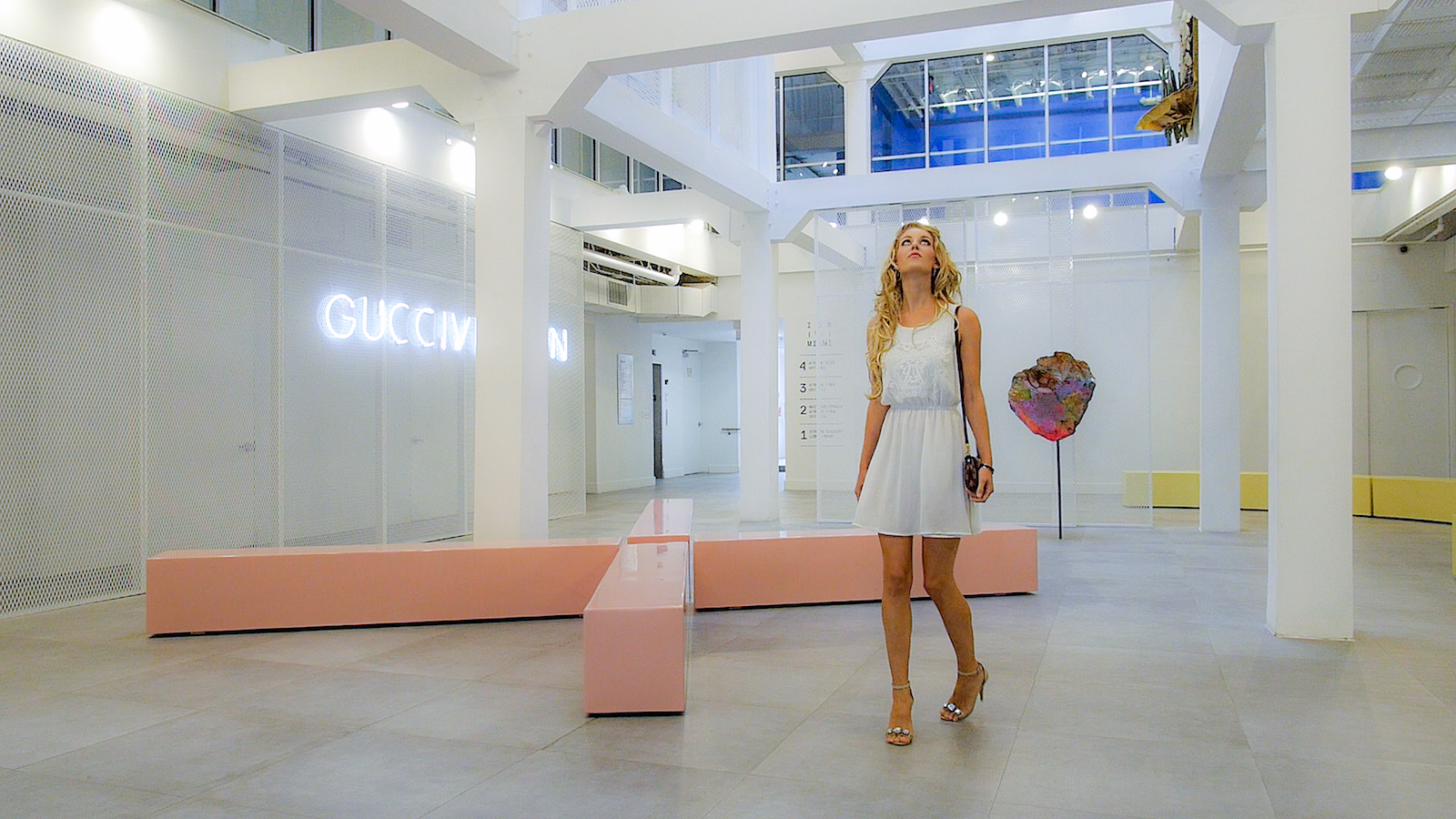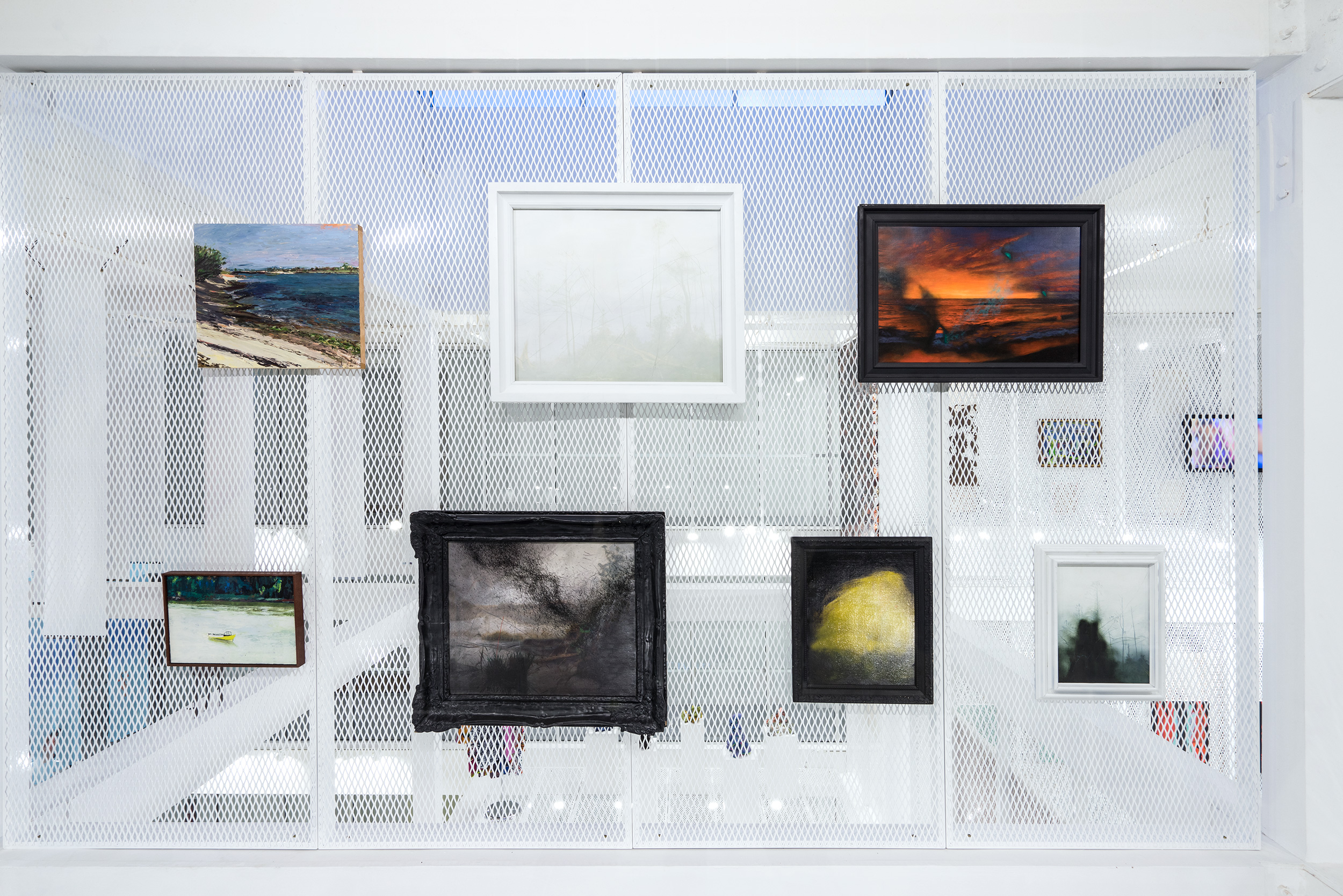
Guccivuitton at ICA: Inventory of art
Above: A view of the Guccivuitton installation. Photo Studio LH00Q, courtesy of ICA, Miami
Everything about the Guccivuitton exhibition at the Institute of Contemporary Art, Miami is disorienting, both physically and conceptually. That’s intentional, coming from the artist collaborative that runs an alternative space in Little Haiti, and whose name, Guccivuitton, is a take on the hyper-commercialism of art and the districts where art houses reside.
ICA, whose exhibitions are all partially funded by the Knight Foundation, sits smack dab in the middle of the rapidly developing luxury center of the Design District, in an iconic old building called the Moore Space. It is a temporary home for ICA, and not ideally suited to showing art; the four-story Atrium space is tight, mixed in with offices. The museum and the gallery knew that, however, and made a point to work within these unique confines. They also decided to create a “show,” playing on the idea of showcases and storefronts, where fashion, jewelry and, yes, art, are sold as luxury items.
The location and timing make a perfect fit. One needs only look at Christie’s New York auction earlier this month, when a Picasso broke the world record for the most expensive piece of art ever sold. Or walk around the ICA’s neighborhood, with its gleaming new Bulgari and Piaget outlets. And yet, the Guccivuitton museum exhibit contains artists whose market value is limited. The paradox is part of the conceptual underpinning.
When you enter the Atrium Gallery on the ground floor, you are greeted by a spray-painted rock that precariously tops a thin steel rod. “Stolen Boulder” by Hugo Montoya resembles a chunk of one of Miami’s now famous street murals, or maybe a piece of the Berlin Wall. But if you step close, and even nudge it, it sways–meaning it couldn’t be as solid as it looks. A “faux” rock? The other works here are a white screen mesh with a neon Gucciviutton sign, and two benches, designed by architect Jonathan Gonzalez. You can look up from these and see the next three stories, which look like white cages and grids hung with artworks.
The ground-floor Atrium Gallery. Photo by Studio LH00Q, courtesy of ICA, Miami.
Proceed up the floors and the feeling of navigating cages continues – a disorienting experience. From various viewpoints, you can see the backs of paintings, or a grouping that seems to be stacked to the ceiling on these racks. Your eyes are never directed to one space or line, like they would be in a white-cube gallery with four contained walls.
These racks, it turns out, are also site-specific works, made from aluminum mesh covered in a white powder-coat finish. “We knew we wanted to fill the space with hanging screens, similar to that in museum or collection storage,” says one of Guccivuitton’s directors, Aramis Gutierrez. “Then we asked our friend, Jonathan Gonzalez, principal of the design firm Office GA and now one of the co-directors of the gallery, to assist us designing the space and coming up with solutions to maximize the outcome.”
Still from promotional video by Wet Heat Project for ICA, Miami.
That outcome does make it feel a bit as though you are digging through storage, albeit a gorgeous storage space. Even though a brochure is provided with a mapping of the works, it isn’t easy to figure out who the artists are.
Those familiar with the Guccivuitton gallery exhibits will be able to pick out some of them by sight – all of the art comes from artists featured in one of their 13 previous shows.
For instance, there are a number of landscape paintings from Florida artist Scott Armetta (landscape is a motif at the gallery, a style of painting that became a little “old-school” in the world of contemporary art, but which the directors are determined to highlight). These are delightful works, subtle but not abstract, often depicting a scene just before sunrise, or after a fire – you can just vaguely make out the ocean front or the swamp emerging from between the heavy, Baroque frames that Armetta uses.
The sculptures from a previous Haitian show are also stand-outs. Some of these are the oldest in the exhibit, such as the metal pieces from Georges Liautaud from the 1970s.
On the other hand, the paintings and sculpture from Loriel Beltran – who, along with Domingo Castillo and Gutierrez, makes up the founding team of Guccivuitton – will jump out, as he has been regularly shown around town for some time. The same goes for Cristina Lei Rodriguez’s sculptures, crafted from a motley assortment of materials such as epoxy, plaster and Plexiglas, in her mission to create forms that look like organic growths from the post-Apocalyptic lagoon. She is currently also featured in a solo show at the gallery.
One piece that could relate to both Armetta and Lei Rodriguez introduces the show on the second floor: it’s a painting sculpture, with a pea-green world rising out of some muck, made from wood, rubber and latex. It’s the only work from Phillip Estlund, but you’ll wish there were more. All the artists have a strong Florida base in their theme or vernacular.
Paintings by Scott Armetta hung on racks. Photo by Studio LH00Q, courtesy of ICA, Miami.
After you orient yourself and realize you are, in a sense, on a shopping tour, sorting through the racks, you’ll find that the Gucciviutton team has taken this to its ultimate conclusion. All the works are available for purchase, through www.guccivuitton.biz.
These are uncomfortable lines to cross. A museum usually doesn’t blatantly sell art from a current exhibition, although everyone knows museums do their fair share of promoting artists that will enhance their collections. Which is again part of the subversive mission here; they are pulling off all the blinders in the relationship between art and commerce, especially its relationship with real estate, gentrification and luxury branding. It should be noted that the ICA itself will not profit from any of the sales, according to Tommy Pace, associate director.
In the end, Pace thought it would be interesting to take this whole art showroom concept to its next level. He proposed to the Guccivuitton directors a “promotional video” to accompany the exhibit online.
They commissioned filmmaker Bill Bilowit of the Wet Heat Project, which makes art documentaries, to produce the commercial. As Bilowit explains, Miamians are familiar with the short videos that accompany any new luxury condo project, those unrealistic portrayals of gorgeous models living at the height of luxury, everything – chic stores, restaurants, etc. – within reach of their fingertips. He knew the humor, and the non-pretension, involved with making a faux copy. He shot a lovely blonde window-shopping in the District, who then encounters Guccivuitton and continues to take in the art the way she does Armani and Givenchy, except that she is all alone, as is usually the case in promos. The world is her oyster.
“The museum approached us about doing a didactic video to help explain the exhibition,” says Gutierrez. “We decided that it would be better to just have someone make a commercial for the show since it is operating as a store anyway.” As Bilowit says, there’s no wink-wink here. “It’s a carefully considered show.”
There are risks here. In an attempt to highlight, and acknowledge, the close ties that contemporary art has developed with commercial enterprise, it could legitimize this process even more–especially given the museum setting. The superb artworks here are not decorative prints made for storefronts, and it may be easy to lose track of that. But then, this is why Guccivuitton at ICA is a daring exhibit. What is the “worth” of art today, and who decides that? It might be the most 21st-century Miami art exhibit yet.
“Guccivuitton” runs through September 25 at Institute of Contemporary Art, Miami, 4040 N.E. 2nd Ave., Miami; 305-901-5272; www.icamiami.org. Admission is free.
Recent Content
-
Artsarticle ·
-
Artsarticle ·
-
Artsarticle ·




